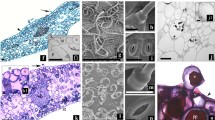Abstract
Disks were isolated from young leaves of winter rape plants and grown in vitro at ambient (15°C) or low (2°C) temperatures for two weeks. In the control disks the growth cessation and beginning of chlorophyll degradation were observed after 1 week of culture. In the low-temperature treated disks the expansion of cells was slower than that in the control material but it continued for two weeks and was accompanied by a marked accumulation of dry matter. Practically, no chlorophyll degradation was observed. The low temperature treatment brought about the decrease in the frost killing temperature of the tissue which was associated with its increased capacity to subcool water. A short (18 h) exposure of the cold-grown leaf disks to slight frost (−5°C) increased further their resistance to freezing, despite the fact that the subcooling capacity of disks decreased in result of the treatment. Therefore, the two stages of hardening, observed previously for the whole plants, can also be detected in the isolated material. In the cold-grown disks, a transient accumulation of reducing sugars but a steady decrease in ATP and water-soluble protein contents were observed. These observations indicate that tissue isolation might affect processes involved in the functional adaptation of cells to cold.
Similar content being viewed by others
Abbreviations
- DTA:
-
differential thermal analysis
- Tk50 :
-
frost killing temperature
- Tin :
-
ice nucleation temperature
References
Bradford MM(1976) A rapid and sensitive method for the quantitation of microgram quantities of proteins using the principle of protein-dye binding. Anal. Biochem. 72: 248–254
Chen THH & Gusta LV (1983) Abscisic acid induced freezing resistance in cultured plant cells. Plant Physiol. 73: 71–74
Dexter ST, Tottingham WE & Graber LF (1932) Investigation of the hardiness of plants by measurement of electrical conductivity. Plant Physiol. 7: 63–78
Eze JMO, Mayak S, Thompson JE & Dumbroff EB (1986) Senescence in cut carnation flowers. Temporal and physiological relationships among water status, ethylene, abscisic acid and membrane permeability. Physiol. Plant 68: 323–328
Flint HJ, Boyce BR & Brattie DJ (1967) Index of injury, a useful expression of freezing injury to plant tissues as determined by the electric method. Can. J. Plant Sci. 47: 229–239
Heller R (1953) Recherches sur la nutritoin minérale des tissues végétaux cultives in vitro. Anal. Sci. Nat. Biol. Végét. 141: 1–223
Kacperska A (1989) Metabolic consequences of low temperature stress in chilling insensitive plants. In: Li OH (Ed) Low Temperature Stress Physiology in Crops (pp 27–40). CRC Press Inc., Boca Raton, Florida
Kacperska-Palacz A (1978) Mechanisms of cold acclimation in herbaceous plants. In: Li PH & Sakai A (Eds) Plant Cold Hardiness and Freezing Stress. Mechanisms and Crop Implications (pp 139–152). Academic Press, New York
Kacperska A & Kulesza L (1987) Frost resistance of winter rape leaves as related to the changes in water potential and growth capability. Physiol. Plant. 71: 483–488
Kulesza L, Pukacki P & Kacperska A (1986) Ice formation and frost killing temperature as related to cold acclimation of winter rape plants. Acta Physiol. Plant. 8: 185–193
Le Saint-Quervel A-M (1977) Recherche et utilisation d'une methode d'evaluation de la résistance au gel de fragments de feuilles. C.R. Acad. Sci. Paris 284: 41–44
Maciejewska U & Kacperska A (1987) Changes in the level of oxidized and reduced pyridine nucleotides during cold acelimation of winter rape plants. Physiol. Plant. 69: 687–691
Park JT & Johnson MJ (1949) A submicro determination of glucose. J. Biol. Chem. 81: 149–151
Reaney MJT & Gusta LV (1987) Factors influencing the induction of freezing tolerance by abscisic acid in cell suspension cultures of Bromus inermis Leyss and Medicago sativa L. Plant Physiol. 83: 423–427
Rychter A, Cieśla E & Kacperska A (1988) Partieipation of the cyanide-resistant pathway in respiration of winter rape leaves as affected by plant cold acclimation. Physiol. Plant. 73: 299–304
Saint John JB (1970) Determination of ATP in Chlorella with the luciferine-luciferase enzyme system. Biochemistry 37: 409–416
Sakai A & Larcher W (1987) Frost Survival in Plants (pp 33–36). Springer-Verlag, Berlin, Heidelberg, New York, London, Paris, Tokyo
Samogyi MJ (1930) A method for the preparation of blood filtrates for the determination of sugar. J. Biol. Chem. 86: 655–663
Sikorska A & Kacperska A (1979) Phospholipid involvement in frost tolerance. Physiol. Plant. 47: 144–150
Tao D, Li PH & Carter JV (1983) Role of cell wall in freezing tolerance of cultured potato cells and their protoplasts. Physiol. Plant. 58: 527–532
van Swaaij AC, Jacobsen E & Feenstra WJ (1985) Effect of cold hardening, wilting and exogenously applied proline on leaf proline, content and frost tolerance of several genotypes of Solanum. Physiol. Plant. 64: 230–236
van Swaaij AC, Talsma K, Krijgsheld K, Jacobsen E & Feenstra WJ (1987) Frost tolerance in cell cultures of potato. Physiol. Plant. 69: 602–608
Zhang MJN & Wilson JHM (1987) An improved conductivity method for the measurement of frost hardiness. Can. J. Bot. 65: 710–715
Author information
Authors and Affiliations
Rights and permissions
About this article
Cite this article
Piotrowska, G., Kacperska, A. Utility of leaf disks cultured in vitro for studies on frost resistance. Plant Cell Tiss Organ Cult 22, 21–26 (1990). https://doi.org/10.1007/BF00043694
Received:
Accepted:
Issue Date:
DOI: https://doi.org/10.1007/BF00043694




